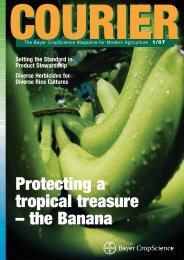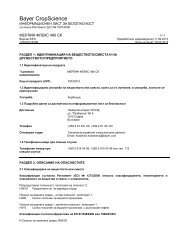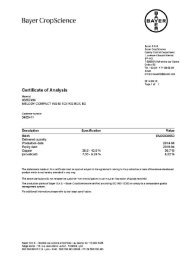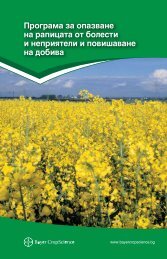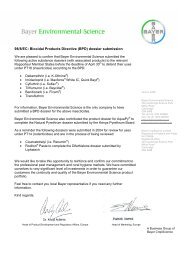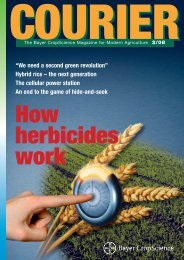Potatoes⦠- Bayer CropScience
Potatoes⦠- Bayer CropScience
Potatoes⦠- Bayer CropScience
You also want an ePaper? Increase the reach of your titles
YUMPU automatically turns print PDFs into web optimized ePapers that Google loves.
For more than a century, the Netherlands<br />
has been a leader in seed potato production.<br />
With an area of approx. 36,000<br />
hectares, it accounts for about 40 percent<br />
of the total Western European acreage. The<br />
Netherlands is the leader in the fields of<br />
new varieties and export, and has made a<br />
name for itself in terms of cultivation<br />
knowledge and modernization. But will<br />
this remain the case Competition from other<br />
countries has increased in recent years,<br />
with France, Germany and Scotland in the<br />
lead. How are Dutch commercial companies<br />
dealing with this And how do they<br />
plan to remain leaders in the world of seed<br />
potatoes The two largest commercial<br />
companies, HZPC and Agrico, give their<br />
vision of the future in five main areas<br />
(competition, varieties, licenses, diseases<br />
and knowledge).<br />
Competition<br />
“Yes, it is true - the Netherlands is losing<br />
something of its lead.” Gerard Backx, General<br />
Director of the commercial seed potato<br />
company HZPC does not beat about the<br />
bush. He sees other countries, with France<br />
furthest ahead, slowly stealing a share of<br />
the market from the Netherlands. “But you<br />
have to consider this in proportion,” he<br />
emphasizes. “Each year the Netherlands<br />
exports about 700,000 tonnes of seed potatoes.<br />
Our most important competitors<br />
France, Scotland and Germany together<br />
export about 230,000 tonnes. I anticipate<br />
that in the coming years, the relationship<br />
will shift at the very most by a few thousand<br />
tonnes. So we are therefore talking<br />
about an approximate one percent change.”<br />
One area in which the Netherlands is miles ahead<br />
of other countries at the moment is the breeding<br />
of (successful) new varieties. Both Agrico and<br />
HZPC are making an important contribution to this<br />
through their own breeding operations (Agrico<br />
Research and HZPC Metslawier).<br />
However, Backx is not saying that the<br />
Netherlands has nothing to fear. “As a<br />
leading seed potato-producing country,<br />
we shall have to keep up in terms of knowledge,<br />
quality and modernization. Other<br />
countries are busily catching up on all<br />
three points. We must therefore do everything<br />
we can to maintain our lead.”<br />
France in particular is doing well<br />
Jan Van Hoogen, Commercial Director at<br />
the commercial potato company Agrico,<br />
confirms these efforts to overtake the<br />
Netherlands. In his view, France in particular<br />
has made great progress. “With regard<br />
to cultivation knowledge, mechanization<br />
and storage technology, the French are no<br />
longer behind the Netherlands. They can<br />
grow potatoes just as well as we can.”<br />
Van Hoogen emphasizes that the emergence<br />
of other countries is not disadvantageous<br />
for the Netherlands per se. “All large<br />
Dutch commercial companies have subsidiaries<br />
or establishments in France,<br />
Germany and Scotland. And in recent<br />
years, they have all grown considerably.<br />
As a result, the market share of Dutch<br />
varieties has also increased greatly. A large<br />
part of the money that we earn from this<br />
returns to benefit Dutch growers.”<br />
Varieties<br />
One point in which the Netherlands remains<br />
miles ahead of other countries is the<br />
breeding of (successful) new varieties.<br />
Both Agrico and HZPC are playing an important<br />
role here with their own breeding<br />
operations (Agrico Research and HZPC<br />
Metslawier). The two commercial companies<br />
each deal in about 100 different potato<br />
varieties, the majority of which they<br />
have bred themselves.<br />
HZPC director Backx says that about<br />
70 of the 100 varieties are being actively<br />
produced and marketed. The others are<br />
either in the introductory or run-down<br />
phases. HZPC aims to get three new cultivars<br />
onto the European List of Varieties<br />
each year. Of these, at least one must<br />
become a commercial success, which<br />
requires that after an introductory period<br />
of three to five years, at least 100 hectares<br />
must be cultivated, with total production of<br />
at least 3000 tonnes. If the variety does not<br />
reach this threshold, it will be withdrawn<br />
from the market as quickly as possible.<br />
“The reality is that many varieties remain<br />
on the borderline. You have to clear these<br />
out so that the successful varieties get<br />
more space on the plots,” is how Backx<br />
describes the strategy. In practice, this<br />
sometimes meets with resistance – but this<br />
is part of the trade, he says. “In the case of<br />
the potato, there is an enormous hodgepodge<br />
of wishes from around the world.<br />
We try to meet these as much as we can –<br />
but not at any price. Sometimes varieties<br />
do well in small niches. But the niches<br />
must ultimately contribute to the orga -<br />
nization’s results. If that fails, we get our<br />
fingers burnt. A variety must be profitable.”<br />
Well-known varieties have a lot of power<br />
According to Backx, the success of a variety<br />
depends on many factors. Obviously<br />
the properties of the variety play a very important<br />
role, but the ‘pulling power’ of the<br />
known major varieties must not be underestimated.<br />
For HZPC, these are above all<br />
the varieties Spunta and Desirée – both<br />
breeds from the ‘forebears’ of the company,<br />
Hettema and De ZPC. Backx: “In important<br />
export markets such as North<br />
Africa, Spunta in particular has a cast-iron<br />
image. The variety stands for confidence,<br />
quality and reliability. For growers in this<br />
region, a new variety should preferably<br />
have the shape and qualities of a Spunta.<br />
And of course the variety must be demonstrably<br />
better.” HZPC does indeed have an<br />
‘improved Spunta’, Backx says. “Only it<br />
takes a great deal of time and effort to<br />
convince our customers of this.”<br />
‘Breed what the customer wants’<br />
According to Agrico Commercial Director<br />
Van Hoogen, the secret of a successful<br />
breed always lies in the wishes of the<br />
customer or consumer. “The art is therefore<br />
to remain in discussion with all parties<br />
in the chain, so that you can provide them<br />
as far as possible with varieties that<br />
possess the desired qualities.” As an example,<br />
he gives the desire of the French fries<br />
industry to be able to use the same variety<br />
all year round, in order not to have to make<br />
any changes in the factory, and to be able<br />
to supply a constant quality to the end-user.<br />
“For us, that means a continuous search for<br />
varieties that produce a high yield early in<br />
the season, and allow storage until the new<br />
season without loss of quality. The closer<br />
we come to that, the more rapidly new<br />
varieties are accepted.”<br />
Licenses<br />
The use of new, licensed varieties is also<br />
vital for both companies in order to regain<br />
the investment made for all the breeding<br />
efforts. After approval on the Variety List,<br />
1/08 COURIER 15





